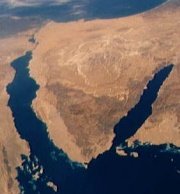Online Encyclopedia
Sinai Peninsula
The Sinai Peninsula (in Arabic, Shibh Jazirat Sina) is a triangle-shaped peninsula lying between the Mediterranean Sea (to the north) and Red Sea (to the south). Its land borders are the Suez Canal to the west and the Israel–Egypt border to the north-east. It is now part of Egypt. The Sinai Peninsula is in Southwest Asia while the rest of Egypt is in North Africa.
The Sinai is almost entirely desert, but is settled along the Sabah coast at Taba (near the Israeli town of Eilat), where there is a hotel and casino. Moving southwards along the coast, there lie: Nuweiba , Dahab and Sharm el-Sheikh. The Sinai is also settled on the north coast near the Gaza Strip at El-Arish.
Mount Sinai in the Sinai is biblically significant as it is allegedly the site where Moses received the Ten Commandments. A monastery situated at St. Catherine in the southern Sinai Peninsula claims to be at the site of Mount Sinai, though historians and archeologists generally reject this as the site.
The eastern boundary of the peninsula is a geological fault zone known as the Great Rift Valley, which can be seen from the upper Jordan River valley,extending southward through the Red Sea into Africa.
History
The Sinai was inhabited by the Monitu and was called Mafkat or Country of Turquoise. From the time of the First dynasty or before, the Egyptians mined turquoise in Sinai at two locations, Wadi Maghareh and Serabit el-Khadim. They were operated on and off on a seasonal basis for thousands of years. Modern attempts to exploit the deposits have been unprofitable. These may be the first known mines.
Modern History
Until the early 20th century, Sinai was under the control of the Ottoman Empire. In 1906 it became part of then British-controlled Egypt, when the Turkish government yielded to British pressure to hand over the peninsula. The border imposed by the British runs in an almost straight line from Rafah on the Mediterranean shore to Taba on the Gulf of Aqaba. This line served as the eastern border of Sinai ever since, and is now the international border between Israel and Egypt.
In 1948, Egyptian forces passed though Sinai on their way to invade the newly-created state of Israel based on a UN mandate dividing the land between the Jews and the Christian and Muslim inhabitants. During the 1948 war, Israeli forces entered the north-eastern corner of Sinai, but withdrew shortly after, following British and American pressure. Under the terms of the 1949 Armistice Agreement, Sinai, together with the Gaza Strip, remained under Egyptian control, although parts of it were demilitarized.
In 1956, Egypt used its control of Sinai to impose a blockade on the Israeli port of Eilat. Following this, Israeli forces, aided by Britain and France (which sought to regain control over the Suez Canal) invaded Sinai, and took control over the entire peninsula within several days (see Suez Crisis). Several months later, Israel withdrew its forces from Sinai, following strong American and Russian pressure.
In 1967, Egypt reinforced its military presence in Sinai, as part of the Arab plan to attack Israel. The blockade on Eilat was renewed, and UN peace-keeping forces were forced out of the area. In the following Six-Day War, the Egyptian army was defeated, and Israel, once again, took control over the entire peninsula. The Suez Canal, whose east bank was now controlled by Israel, was closed.
In the 1973 Yom Kippur War, Egyptian forces managed to take over the east bank of the Suez Canal. As part of the following cease-fire agreements, Israel pulled its forces out of a strip in western Sinai, allowing for the re-opening of the canal.
In 1979 Israel and Egypt signed a Peace Treaty, in which Israel agreed to transfer control over Sinai to Egypt. Subsequently, Israel pulled out of Sinai in several stages, ending in 1982. The Israeli pull-out involved the destruction of several Israeli settlements including the town of Yamit in north-eastern Sinai.
External links
- The History of the Ancient Near East http://ancientneareast.tripod.com/Sinai_Peninsula.html
- Geographia: Sinai's history map, the Bedouin http://www.geographia.com/egypt/sinai/
Censored page

